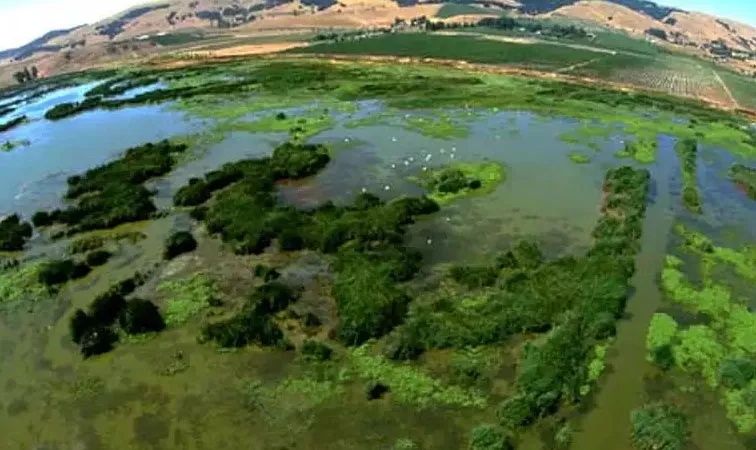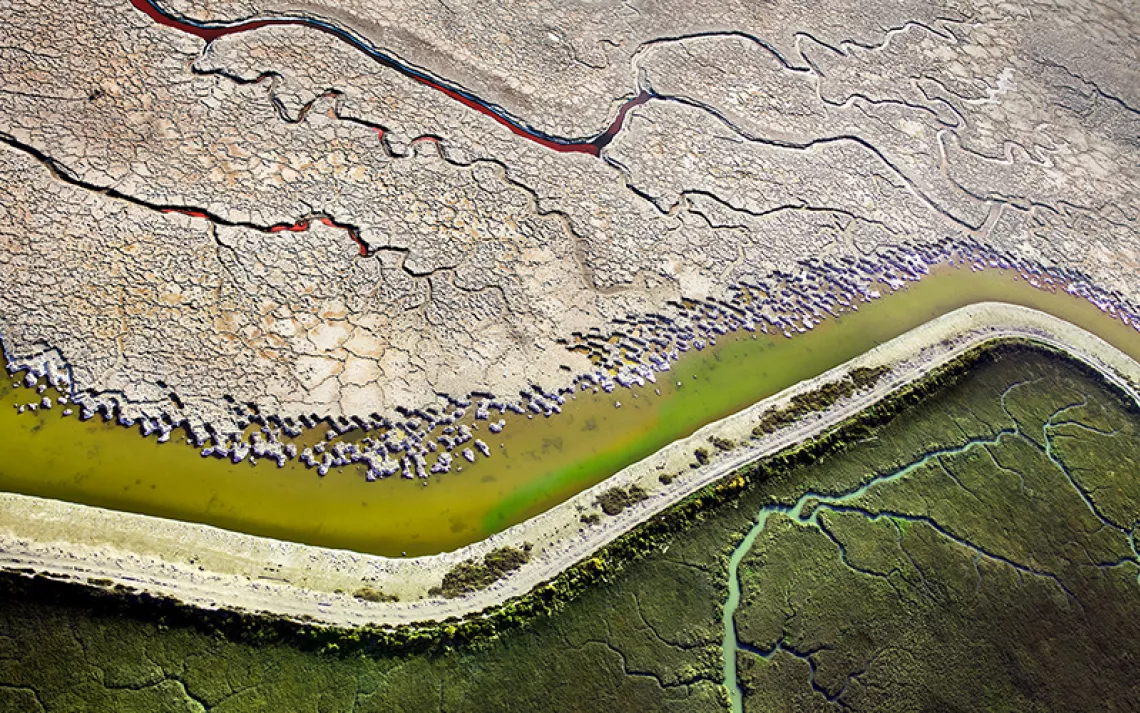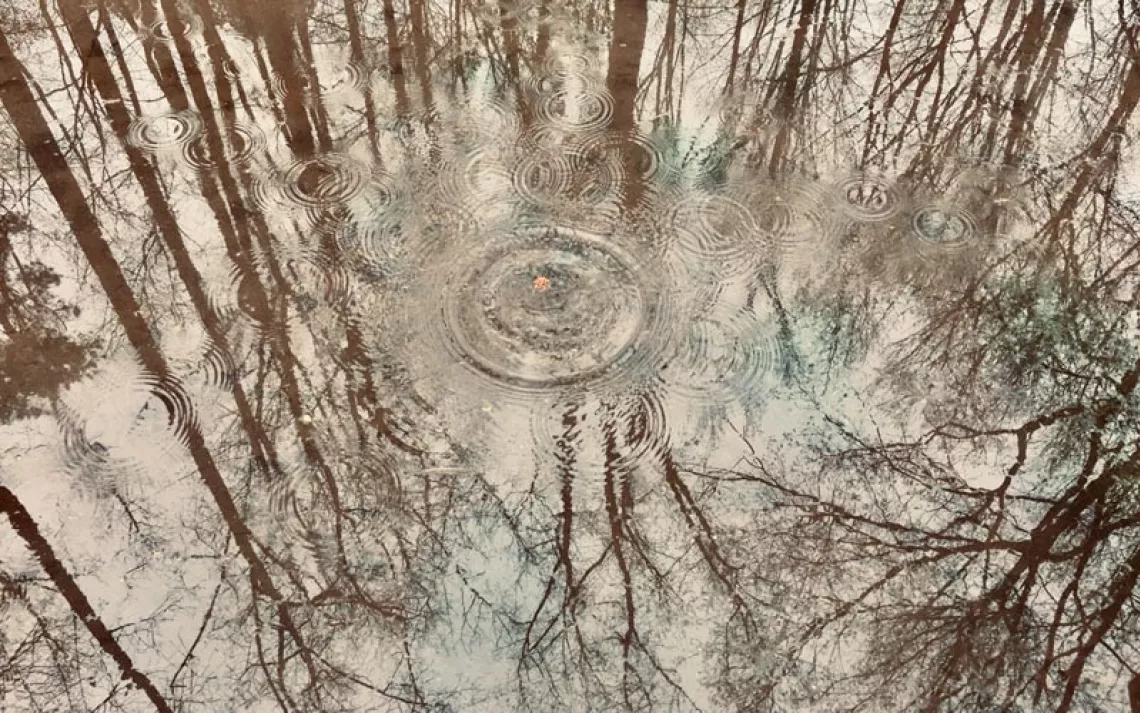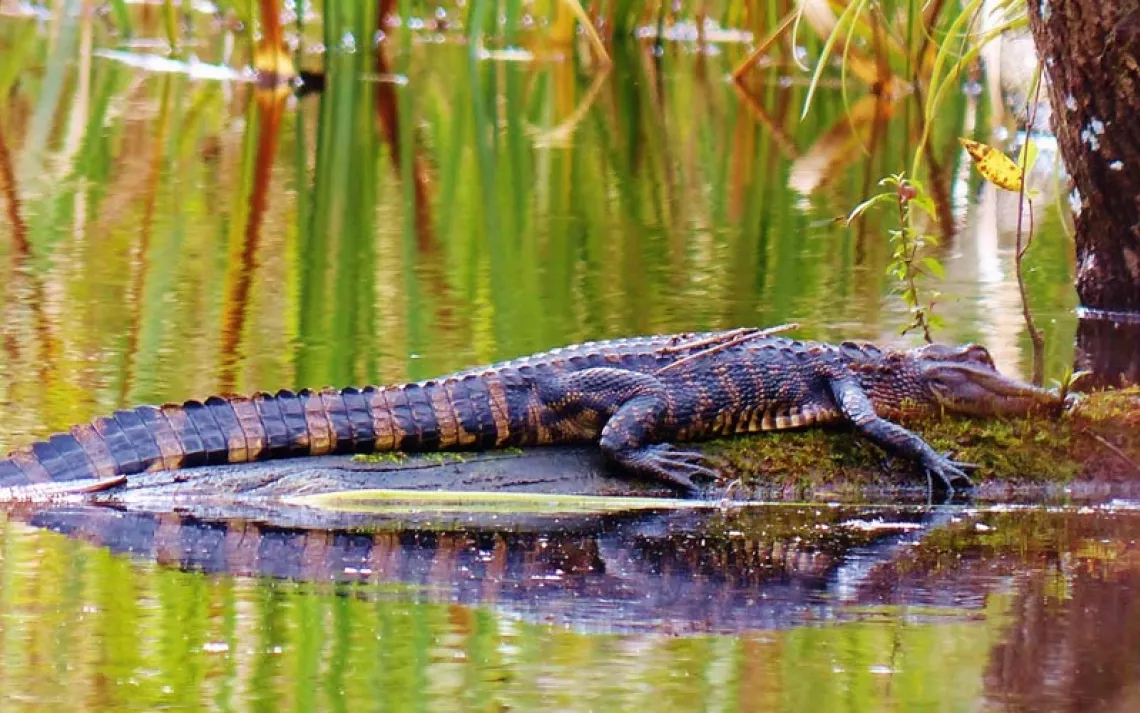Viansa Wetlands: Resurrection of a California Marsh
Just add water

The wetlands owned by Viansa Winery | Photo Courtesy Viansa Winery
In the summer of 1988, Sam Sebastiani climbed a hill in California’s Sonoma County and looked about for a new beginning. Not long before, Sam had been president of Sebastiani Vineyards, one of the state’s biggest wine producers. On New Year’s Day 1986, the chairwoman of the company, Sylvia Sebastiani--his mother--had fired him in a dispute over the direction of the family business. He was now searching for a place to start again. This hill was made of volcanic tuff, perfect for digging caves in which to age barrels. The property had a run of the red soil he wanted for his vines. He liked the view. Westward stood the Carneros hills. Eastward lay the Sonoma floodplain, an expanse of diked and drained bay lands, with tidal creeks and sloughs shining in the distance. Directly beneath the hilltop was the poor stubble of a very marginal hayfield.
The hayfield was a fossil marsh. It had the hydric soil characteristic of former wetlands. Had Sebastiani descended to the field and dug up a handful, he would have smelled the telltale sulfidic odor; seen the histosol, the high organic content of the surface layer, the organic streaking, the gleyed, low-chroma, blue-gray color. Digging deeper, he would have found long-dormant seeds of marsh sedges and the sleeping rhizomes of tules and cattails. This field had been a cove in the marshy plain of reeds that bordered San Francisco Bay before the gold rush, when the bay was twice its present size.
Sebastiani did not dig up the soil and smell; not that day. But something in the lay of the land--in the way the flat embayment of the field nestled in an amphitheater of hills--must have murmured marsh to him, for now he saw a kind of mirage. The field flooded in his imagination, its stubble greening and lengthening into stands of cattails and the 20-foot culms of bulrushes, with mallards and pintails swimming underneath them.
The mirage was refracted light from his childhood. His growing up had been equal parts vines and birds, for those had been the passions of August Sebastiani, his father. “Duck pond,” Sam thought. (His father had built duck ponds. “Wetland” was lingo he would not encounter until he began rubbing elbows with the biologists who knew how to bring back the reeds.)
“The task of developing marshlands presents no serious problems,” Herbert Mason writes in A Flora of the Marshes of California. “Given adequate water of proper depth, a marsh is inevitable.” Inevitable in nature, perhaps, but not in the affairs of men. Herbert Mason never had to deal with the U.S. Army Corps of Engineers, EPA, Fish and Wildlife Service, and Department of Justice; the California Department of Fish and Game, Department of Transportation, Regional Water Quality Control Board, and State Lands Commission; the Sonoma County Board of Supervisors, Water Agency, and Planning Department; the Marin-Sonoma Mosquito and Vector Control District; and the San Francisco Bay Conservation and Development Commission--all agencies to which Sebastiani had to apply in his two-year quest for the permit he needed to “develop” his marsh. Such scrutiny was necessary because Sebastiani wanted to build a levee--a structure that would destroy one acre of wetland in the process of creating nearly a hundred more.
Today, recalling his struggles with red tape, Sebastiani goes glassy-eyed and bewildered, like Kafka’s Joseph K. after his ordeal in The Trial. Without the funding, advice, and encouragement of the hunter’s group Ducks Unlimited, Sebastiani says, he would have given up. Sebastiani also had nature on his side. A former marsh wants to be marsh again. His permit in hand, Sebastiani built a 1,700-foot-long levee on the northern border of his land. The winter rains came. The runoff ponded behind the levee. Cattails, bulrushes, and sedges sprang from the dormant seed bank. Pondweed and the seeds of spikerushes and other marsh vegetation washed in on high water, or hitched in on the plumage of birds. Waterfowl saw the glint of water, noted the greening margins, and set down.
By the second year, 156 species of birds had been recorded in or around Viansa Wetlands, as Sebastiani called his little reserve next to Viansa Winery. On a single winter day, 10,000 waterfowl were counted on its 90 acres. Nearly every North American duck species has paid a visit: two species each of goldeneye, scaup, and wigeon; three each of merganser and teal. Tundra swans. Shovelers. Canada geese. Brant. One albatross. Of the 35,000 canvasbacks that winter annually on San Francisco Bay, about 10 percent spend time in Viansa Wetlands. Red-tailed hawks and three species of owl nest here. Eight species of hawk hunt through, and four species of falcon, and the golden eagle. The marsh has recorded one species of starling, two of dove, three wrens, four grebes, five flycatchers, six gulls, seven sparrows. No partridge, yet, on any of Sebastiani’s transplanted willow trees, but its cousin, the quail, runs in file down the levees. Another cousin, the ring-necked pheasant, is occasionally flushed from leveeside reeds. “If there is magic on this planet, it is contained in water,” Loren Eiseley writes. Water has certainly worked its magic in Sam Sebastiani’s hayfield.
If the winemaker imagined that his resurrection of the marsh was a one-time event, he underestimated. His is a seasonal marsh. By late summer, it has dried almost entirely--nothing but weary, bent tules and polygonal cracks in sunbaked mud. After winter rain, it all begins again. As long as the levee holds, the magical reappearance of the reeds will be cyclical and endless.
It is startling how fast each springtime resurrection progresses. Cattails and bulrushes grow faster than any plants save giant kelp, and even as the reeds are rising, the high water of winter rains is receding. A marsh in winter flood has little topographical relief, but in spring, as the cattails wax and the water wanes, topography comes rapidly upon it. The relief sharpens daily, and soon the channels and embayments make deep, reed-walled canyons.
Spring is sequential on the levee. It sprouts first in wild radish along the crown, then moves on down the levee’s inner bank as the falling water makes way for it. As the waterline retreats, there is a brief interregnum--a day or two of shoreline mud--then a new sward of wild radish springs up. The radish quickly come into flower--varicolored blossoms of pink, blue, white--then the flowering, too, moves downbank. You see the same sort of graduated springtime in the mountains, where alpine plants germinate as the snow melts upslope. Here, the germination proceeds in the opposite direction. Walk five feet down the levee bank, and your feet are in another season; you have reached a somewhat newer spring.
Spring is slow to arrive up in the adjacent vineyard. The vines remain “in wood” while the cattails shoot skyward. Bare, dormant trellises run down to the fast-rising, spring-green shore of reeds. Then consecutive days of warmth quicken the vines. First budswell, then budbreak, then the first green shoots, then tiny leaf clusters, then pre-bloom. Common vetch, the bean planted between rows of vines to fix nitrogen, sets its extravagant white flowers and then is disked under.
Along shore, at the base of the cattails, the opaque and muddy water of winter clarifies. The sediment load is settling out with the passage of time and the purifying influence of cattails and bulrushes. The marsh is distilling itself.
The Russian olives that Sebastiani planted at wide intervals along the levee have sent out frosty-green, willowlike foliage. Downwind of each small tree is a plume of powerful fragrance, a peculiar, cloying sweetness; a fermented smell, somehow. The little grove of cottonwoods that the winemaker planted at the southwest corner of the marsh fills the area with the clean, tonic fragrance of riparian trees. One day a worker drives a mower down the crown of the levee. The next a big gopher snake, fat with spring voles, suns itself on the mown grass.
The muskrats are now living large. They have switched completely from the Irish famine of muskrat winter--a dogged subsistence on the starch of tubers--to the delicacy of cattail shoots, in which nutrients are concentrated for the fast growth of spring. On their rafts of felled cattails, there are no longer any tuber fragments among their leftovers; just pale strips of shoots, the ends serrated with teeth marks. In the vineyard the vines bloom, and the trellises green up. Early in the season, growth is almost exponential in grapevines. The yellow-green of new grape leaves, and of grape tendrils searching, now match the yellow-green of that same furious growth in the rising walls of cattails. This explosion of green is particularly beautiful at dawn and sunset. Here and there atop the evening-green cattails and trellises, the low, reddened sun reflects, redoubled, from the red epaulets of red-winged blackbirds.
In July the bulrushes begin to lose their starch. The proud, erect culms of springtime commence bending over on themselves. The cattails, too, lose their good posture. The reeds are fatiguing with age and the weight of perching egrets and herons. Marsh wrens must take a toll as well. The long-billed bird weighs almost nothing, but its endless running up the reeds, and its gleaning the culms at waterline for snails, and its launching itself from reedtops to hawk flying insects, all must contribute to the decline of the reeds. The nemeses of the wrens, the red-winged blackbirds, weigh more and ride the reeds harder. Flashing red, bobbing with the reed tip, singing o-ka-lee-onk, the blackbirds steal the flex from the culms. The tules are worn out by song.
A thickening soup of duckweed and pondweed stills the surface of the marsh. The water jells, almost, with vegetation, so that light winds no longer leave a mark. Each sort of water plant calms the surface in its own way. One species of pondweed, Potamogeton nodosus, floats its leathery, lanceolate leaves on the surface. Another species, Potamogeton foliosus, drifts long, wiry, filamentous leaves. Water-starwort makes its particular kind of dimpling, and marsh pennywort makes another. Looking across the marsh into bright sun, you see a complicated mosaic of textures.
Wading into this mosaic is like striding through molasses. Your feet quickly become entwined and freighted with heavy boots of pondweed. Sometimes by walking backward you can shuffle free of these loads, but if you wait too long, and the pondweed boots accrete too large, this technique ceases to work. You stop, stoop, grunt, rip the weed off by hand, and fling it away in irritation.
The gumbo of the marsh is seasoned now with floating feathers--some pepper of wren and coot, but mostly salt of egret. The white plumes and down of egrets drift high and dry for a while--dazzling points of light--then become waterlogged and sink. As summer advances, the proportion of feathers in the gumbo increases, and so does the flotsam of shed skins of mosquito wigglers and dragonflies and frogs, and the floating corpses of minnows, tadpoles, and crabs. The marsh collects the debris of its own fertility and grows a bit bedraggled. The once-immaculate green of the reeds is now flecked and spattered everywhere with white guano.
The muskrats have broadened their diet to include spike-rushes, Sagittaria, water plantain, and assorted sedges, but they continue felling cattails, and their slash-and-eat agriculture leaves small clearings everywhere in the tules.
Resident birds remain in the marsh, but the migrants are long gone. The summer marsh has a deserted feel. Two ducks common in the winter marsh--the canvasback and greater scaup--are now up in the Yukon and the Seward Peninsula. The lesser scaup has traveled nearly as far. The sea ducks--common goldeneyes and buffleheads--are up in central Alaska. Barrow’s goldeneye is working its way westward out the Aleutian peninsula. The blue-winged teal has reached the British Columbia coast, the Yukon, and central Alaska. The wood ducks are up in Idaho and Montana and Vancouver Island. The shovelers and pintails have reached the northern plains and have spread through much of Alaska. The tundra swans are up in the tundra. The Caspian terns have reached Great Slave Lake and Lake Athabaska. The Canada geese are scattered throughout Canada, save the highest islands of the Arctic. The armies of shorebirds--greater and lesser yellowlegs, long-billed and short-billed dowitchers, willet, sandpipers, whimbrels, curlews, godwits, dunlins, snipes--have worked their way far to the north, foraging by day and traveling by night. Many have outdistanced the night, finally. They have reached the latitudes of perpetual light and they travel the last miles, of necessity, by day. They are up with the snowy owls, caribou, and barren-ground grizzlies. The elements of Sam Sebastiani’s marsh are scattered now across much of the Northern Hemisphere.
By October, the marsh is dry again except for its deep northern bay and a few small central pools. The meadows of pondweed and algae, as the water drains from under them, have come to rest on the bottom. The floating flora has lost its third dimension. It dries and compresses to a kind of papier mâché, a natural papyrus, that covers most of the shallow basin of the marsh. Only the faintest hint of green remains, the same doubtful color you see in leaves pressed between the pages of a book. Here and there on the papyrus crust lie the skeletons of carp and empty carapaces of crabs. The pondweed mâché makes a faint, resonant drumbeat under your shoes. With the edge of your sole you can scuff up a scroll of it, exposing bare mud beneath.
Receding water concentrates most of the marsh’s frogs in the channel along the east levee. They bob up for air by the hundreds, each with a quick gulp--nose and eyes above the opaque water--then a plop back under. The plopping patterns the channel surface everywhere, like rebounding raindrops in the shape of frogs. The frogstorm patters away under cloudless skies, unnatural and ominous, an Egyptian plague on Sam Sebastiani’s marsh.
Then one morning, deliverance from the plague. A small army of white herons--great egrets and snowies--descends on the northern bay of the marsh. They work their way southward, making easy pickings of the fish and frogs trapped in the shallows. When they are done, only a few token frogs remain.
With each seasonal death of the marsh, some of the carp, crabs, and crayfish succeed in escaping to the brackishness of Sonoma Creek, from which they migrated. Many crayfish flee the sun downward, tunneling after the subsiding water table until they reach moist mud in which to estivate. In the depths, metabolism slowed, they wait for the rains. They bide their time until the marsh blooms again.
The cattails have gone to seed. The tiny, tight-packed seeds cover each cigarlike spadix in firm brown velvet. (“Reed mace,” the English call cattails, in honor of this dark sausage at the business end of the stalk.) Beneath the brown velvet of the seed capsules, a white kapok of cottony seed-parachutes packs the core. Nearly weightless individually, the parachutes are folded in so cunningly and densely, in such vast numbers, that each cattail has heft.
Strip an autumn spadix into the breeze, with the sun downwind, and half the sky fills with backlit parachutes. Each cattail explodes like a supernova, emitting impossible volumes of matter and light. The disintegration comes in pulses. The seeds never go all at once. Left to nature, the wind spalls them off in swatches, and in human hands it is the same. You cannot thumb away just one flight of seeds, for the effect is too satisfying, too spectacular. You are compelled to follow that first flight with a second, then a third. Great clouds of potential cattails--expanding nebulae of marsh-to-be--sail away on incandescent wings. A marsh is a biome itching to repeat itself. Marshlands have suffered brutal reductions in the past, but the future of marshes always looks bright.
The winter rains come again. The marsh fills. A small flotilla of ruddy ducks moves into flooded autumn reeds. The males among them wear gray winter plumage. The bright blue bill of the breeding season has faded to a dull blue-gray. The very ruddiness of the ruddy drakes has vanished, and the males are hard to distinguish from the hens.
At summer’s end, most North American male ducks molt their bright breeding plumage and spend a few months in cryptic “eclipse” plumage. Some species, like the ruddy, remain in eclipse until the next breeding season. They lose their flight feathers along with their color, and until the next molt are unable to fly. Drab, feminized, flightless, they retreat into the depths of the marsh and hide. These unruddy winter drakes in Sam Sebastiani’s marsh looked as gray and weathered as old decoys left out in the rain.
Sebastiani, I remembered, had inherited antique wooden decoys from his father. In the difficult early days of Viansa Winery, he had been forced to sell this patrimony, along with his prize mules and other possessions, in order to make ends meet. He had lost the big home where he and his wife, Vicki, had entertained extravagantly. Vicki, embarrassed by her new circumstances, had gone into hibernation as a hostess. Sam had gone into eclipse plumage as surely as any of these ducks.
In an astronomical eclipse, we know--most modern humans do, at least--that the sun or moon will emerge again. In the eclipse of his fortunes, Sam had no such certainty, no guarantee that his winter would ever turn to spring. “Now I go around the country, making my speech about wetlands to growers and people in wastewater management,” Sebastiani told me recently, on the Viansa hilltop, where his winery and Italian cafe now have 100 employees. “I tell them, get yourself a wetland. Because that way you’ve created more life. When you get in your car, and go home, and see a bird fly by, you might have put that bird on the planet.”
 The Magazine of The Sierra Club
The Magazine of The Sierra Club



